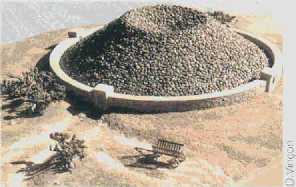To know more see
https://www.encyclopedie-environnement.org/en/air-en/dew/
Dew, as a source of pure water…
Why dew?
Dew is a source of pure water, modest, generally, but which can prove to be an essential contribution in the places where water is missing most: deserts. Many hot countries suffer from the absence of water. However, its amount in the atmosphere can be considerable.
Man started very early to try to collect dew to feed out with fresh water. He also realized that such water could appear in an unexplained way. There are several testimonies, even legends, which speaks about dew collected in an artificial way. For example, in the steppe of Tourane in the ex – USSR, there is a large artificial hill filled with crushed stones. On the top of the hill, vestiges of scythe constructions used for worship are visible. Lower, within 1,50 m, two sources of very pure and cold water are found from where water always always runs abundantly. What is astonishing, is that around this hill no natural source has been found. Could the source of the water be condensation?
One also heard about the dew ponds of England. These artificial ponds were built in the Middle Ages. In the evening, people emptied them and the morning they were once again full of water. These constructions were carried out in a very simple way: in dry areas, one dug basins of a few tens of meters in the form of a cup. One covered the bottom of this cup with a layer of dry straw and a bed of clay. Then the whole was packed and covered with stones. The pond was then ready to function and started to fill with water without any atmospheric precipitations.
In the Canary Islands, the vineyards are planted at the center of a conical hole in the volcanic ash and the humidity necessary to the plant growth is attributed to dew.
Thus, it seems that atmospheric water condensers have existed since olden times. They are known, and yet at the same time they are not known: known by the means of numerous legends, stories, accounts; unknown, because, at the present time, we have only a few documents confirming the veracity of these facts.
On the other hand, one can affirm the existence of such condensers in the XXst century. It took eighteen months for the Belgian Achilles Knapen, prize winner of the “Société des ingénieurs de France”, between July 1930 and end of 1931, to build in Trans-in-Provence, a massive tower which shelters in its center an “air well”, called there a “up side down pit”, nine meters high and ten meters diameter. The construction has fallen into (will fall in) disuse, since far from holding its promises, on the best nights the condenser only collected a bucket of water.
The idea had to his mind following work from the director of the Station of agricultural physics and bioclimatology of Monpellier, Leon Chaptal, who in 1929 erected a pyramid, three and a half meters high.
In 1930, the Chaptal condenser recovered a hundred liters during the six hottest months, between April and September. A value which decreased by a factor two the following year, the conditions having been less favorable. Leon Chaptal, in turn, was inspired by the encouraging results of the surprising experiment of a Russian engineer, Friedrich Zibold. In Féodosia, in Crimea, during the summer 1900, while leveling its forest district, Zibold discovered large conical stone heaps, of volume approximately 600 m3 volume.
In the majority of cases, remnants of clay pipes
surrounded these tumuli. Zibold concluded, as will be shown later, wrongly; but which gave rise to an astonishing construction, that these stone heaps were dew condensers. He decided that the tumuli were used to feed with of drinking water the antique Feodosia.
To verify his assumption, F. Zibold built a condenser functioning on principles that he thought identical to those of the old condensers. For this experiment, Zibold choosed a place at the top of Tepe-Oba, close to Feodosia, at 288 m elevation. He built a stone condenser, in form of a cup, 1,15 m depth and 20 m diameter. The cup was filled with sea pebbles from 10 to 40 cm in diameter, arranged in the form of truncated cone 6 m height and 8 m diameter at the top. The condenser began to be operated in 1912, and gave till 360 liters of water per day. The experiments had to cease in 1915 because of leaks in the base. Partially dismounted, it was completely abandoned. Today, there remains only one gigantic cut 20 meters in diameter.
We think now that, the “ideal” dew condenser should be the contrary of the constructions built at the beginning of the last century and based on higt mass. Condensers must be light to cool quickly during the night. They are in fact similar to the grass in the meadows which, covered with dew, constitutes an important source of water for a number of animals, small (insects) or large (sheep in Scotland, horses in Namibia). Even in the desert, some plants feed themselves with water thanks to the dew forming on their leaves.

in Feodosia (Ukraine)- model

in Trans-en-Provence (France)


